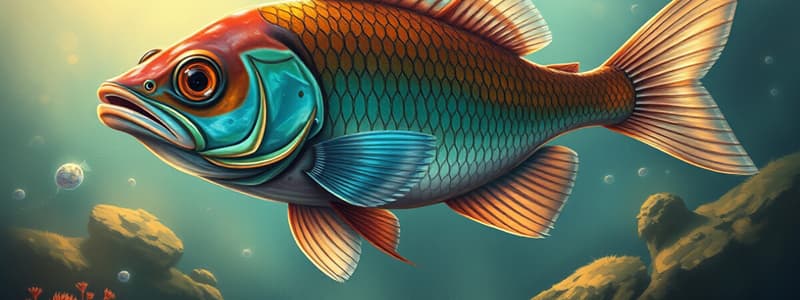Podcast
Questions and Answers
Fish are the most numerous and widespread of the vertebrates.
Fish are the most numerous and widespread of the vertebrates.
True (A)
How many species of fish are there?
How many species of fish are there?
22,000 species
How are the species of fish divided between fresh and saltwater sources?
How are the species of fish divided between fresh and saltwater sources?
59% saltwater, 40% freshwater, 1% in both
What are the three classes of fish?
What are the three classes of fish?
What is another name for Class Agnatha?
What is another name for Class Agnatha?
What are the characteristics of Class Agnatha?
What are the characteristics of Class Agnatha?
What two species are under Class Agnatha, and how many species of each are there?
What two species are under Class Agnatha, and how many species of each are there?
Describe the lamprey.
Describe the lamprey.
Describe the hagfish.
Describe the hagfish.
What is another word for Chondrichthyes?
What is another word for Chondrichthyes?
What animals are included in this class?
What animals are included in this class?
What are their bones made of?
What are their bones made of?
What are the two advantages of Chondrichthyes over Agnatha?
What are the two advantages of Chondrichthyes over Agnatha?
The largest shark, the whale shark, is a carnivore.
The largest shark, the whale shark, is a carnivore.
What do most sharks prey on?
What do most sharks prey on?
Describe the shark.
Describe the shark.
What is a lateral line?
What is a lateral line?
What is a placoid?
What is a placoid?
Male and female sharks remain separate.
Male and female sharks remain separate.
Describe fertilization in its barest details. How many young are produced? Are they dependent?
Describe fertilization in its barest details. How many young are produced? Are they dependent?
What makes skates and rays similar to each other but not sharks? Describe them.
What makes skates and rays similar to each other but not sharks? Describe them.
What is another name for Class Osteichthyes?
What is another name for Class Osteichthyes?
They are the most numerous species among the fish.
They are the most numerous species among the fish.
What are some examples of species in Osteichthyes?
What are some examples of species in Osteichthyes?
What are the three sub-classes of Osteichthyes?
What are the three sub-classes of Osteichthyes?
What subclass do the fish cod and perch belong to?
What subclass do the fish cod and perch belong to?
What are some characteristics of ray-finned fish?
What are some characteristics of ray-finned fish?
What is the operculum?
What is the operculum?
Where does fertilization occur in fish?
Where does fertilization occur in fish?
How does fertilization occur in fish?
How does fertilization occur in fish?
What is milt?
What is milt?
Flashcards are hidden until you start studying
Study Notes
Overview of Fish
- Fish are the most numerous and widespread vertebrates.
- There are approximately 22,000 species of fish.
- Distribution: 59% saltwater, 40% freshwater, 1% inhabit both environments.
Classes of Fish
- Three primary classes:
- Class Agnatha (jawless fish)
- Class Chondrichthyes (cartilaginous fish)
- Class Osteichthyes (bony fish)
Class Agnatha
- Characteristics:
- Slimy skin, unpaired fins, and eel-like bodies.
- Possess a notochord and a cartilaginous skeleton.
- Major species:
- Lampreys and hagfish, totaling approximately 70 species.
Lampreys
- Feed parasitically using a sucker-like mouth with hard teeth to extract blood from prey.
- Damage commercial fisheries, especially in the Great Lakes.
- Larval stage lives in streams for several years before metamorphosing into adults.
Hagfish
- Dwell on the ocean floor and are scavengers.
- Mouth has fleshy tentacles and rows of tooth-like plates for tearing flesh.
Class Chondrichthyes
- Composed of sharks, skates, and rays.
- Bones are made of cartilage.
- Advantages over Agnatha:
- Possess biting jaws and paired fins, allowing for better stabilization.
Sharks
- Are carnivorous and prey on fish and bottom-dwelling animals.
- Features:
- Streamlined bodies and paired fins enhance maneuverability and stability.
- Paired gills facilitate efficient gas exchange.
- Equipped with sharp, triangular teeth that can be continually replaced.
- Lateral line system detects movement and vibrations in the water.
Reproduction in Sharks
- Males and females are generally separate, meeting only for mating.
- Internal fertilization occurs, producing 2 to 60 fully formed, independent young.
Skates and Rays
- Similar to sharks but have flattened bodies and enlarged pectoral fins.
- Often bury their mouths in the sediment and take in water through spiracles.
Class Osteichthyes
- Known as bony fish and represent the most numerous fish species.
- Examples include trout, salmon, cod, perch, sole, eel, and halibut.
- Three sub-classes:
- Ray-finned fish
- Lungfish
- Lobe-finned fish
Ray-Finned Fish
- Exhibit a wide diversity, found in nearly all aquatic habitats.
- Their gills are protected by an operculum, a bony plate.
- Possess a two-chambered heart and flat, flexible scales covering their bodies.
Reproductive Process
- Fertilization occurs externally:
- Females lay numerous eggs, and males deposit milt, a sperm-laden fluid, over them.
Studying That Suits You
Use AI to generate personalized quizzes and flashcards to suit your learning preferences.




